
|
|
SUBSIM: The Web's #1 resource for all submarine & naval simulations since 1997
 |
SUBSIM: The Web's #1 resource for all submarine & naval simulations since 1997 |
|
|
 09-03-15, 04:05 PM
09-03-15, 04:05 PM
|
#1 |
|
Navy Seal
 |
For some it will be difficult to understand the explanation above. Stay tuned for the video. I'll be asking questions afterwards to try to improve my explanations so everyone can understand just how the (insert appropriate curse word here) US TDC really works. The video and copy of the above explanation will be in my Sub Skippers Bag of Tricks thread.
__________________
Sub Skipper's Bag of Tricks, Slightly Subnuclear Mk 14 & Cutie, Slightly Subnuclear Deck Gun, EZPlot 2.0, TMOPlot, TMOKeys, SH4CMS |

|

|
 09-03-15, 05:36 PM
09-03-15, 05:36 PM
|
#2 |
|
Captain
 Join Date: Aug 2009
Posts: 481
Downloads: 74
Uploads: 3
|
I thought I would try to word this another way, not saying that anything RR said is wrong though.
There are two major differences between the German TDC and the American TDC. In my book one is a major advantage and the other is a disadvantage required to make the other work. In the american TDC, the AOB is not coupled to periscope bearing. Moving your scope will not change the AOB. I increased size and bolded there because this cannot be stressed enough. The typical german method of pointing your periscope at 0 and entering the track angle then just point the periscope at the target to get AOB does not work. This is a disadvantage. In the american TDC, the optional position keeper tracks the target and your own subs movements and updates the torpedo gyro angle in real time, even if you are not tracking the target with any sensors at all. Again, cannot be stressed enough. This is clearly a major advantage.
__________________
My SH4 LP |

|

|
 09-03-15, 07:16 PM
09-03-15, 07:16 PM
|
#3 |
|
Navy Seal
 |
Interestingly, in real life the American periscope could automatically send data to the TDC and would work just like the German one if they so chose. So many things about the real TDC have been nerfed and dumbed down for the game. And radar range and bearing were also automatically linked to the TDC if desired. Plus there were two crewmen tasked with making sure the TDC data was accurate according to the plot and the data developed from sensors.
And ColonelSandersLite, those are the two sentences that will be on the test. Thank you.
__________________
Sub Skipper's Bag of Tricks, Slightly Subnuclear Mk 14 & Cutie, Slightly Subnuclear Deck Gun, EZPlot 2.0, TMOPlot, TMOKeys, SH4CMS |

|

|
 09-07-15, 02:55 AM
09-07-15, 02:55 AM
|
#4 | |
|
Captain
 Join Date: Aug 2009
Posts: 481
Downloads: 74
Uploads: 3
|
Quote:
If you (or someone else) can show me good proof of that, I might have an idea of a way to make that work in game. I don't even want to try without knowing for sure though as the temptation to use it anyways would be pretty strong...
__________________
My SH4 LP |
|

|

|
 09-07-15, 09:10 AM
09-07-15, 09:10 AM
|
#5 | |
|
Navy Seal
 |
Quote:
It's possible that someone with a better working technical vocabulary than I could read the same material and say "You dummy! Right there it is." But my eyes are swimming around aimlessly right now and my brain is overloaded analyzing some pretty deep stuff. So my provisional and falsifiable answer is that it doesn't look like the periscope operator had any controls to automatically send bearing and range to the TDC, whether with a momentary send data switch or with continuous data feed. I'm headed over to the Submarine Fire Control Manual for Attack Procedure and find instructions for one of the two TDC operators: 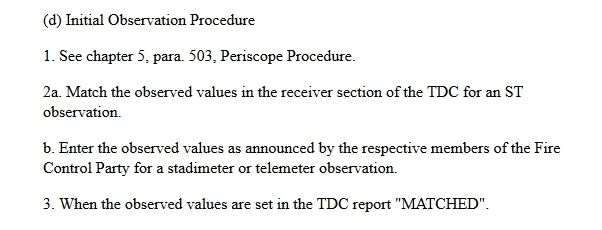 So it looks like he CHECKS to see that the radar values input automatically match the announced data, but he ENTERS "observed values as announced.....for a stadimeter or telemeter observation." I'm going to have to say that unless conflicting evidence is found our game has it right on this one.
__________________
Sub Skipper's Bag of Tricks, Slightly Subnuclear Mk 14 & Cutie, Slightly Subnuclear Deck Gun, EZPlot 2.0, TMOPlot, TMOKeys, SH4CMS Last edited by Rockin Robbins; 09-07-15 at 10:43 AM. |
|

|

|
 09-07-15, 10:40 AM
09-07-15, 10:40 AM
|
#6 | |
|
Swabbie
 Join Date: Jan 2011
Posts: 12
Downloads: 21
Uploads: 0
|
Hi Gentlemen,
Quote:
http://archive.hnsa.org/doc/fleetsub...chap14.htm#14C -- Regards Maciek |
|

|

|
 09-07-15, 10:50 AM
09-07-15, 10:50 AM
|
#7 | |
|
Navy Seal
 |
Quote:
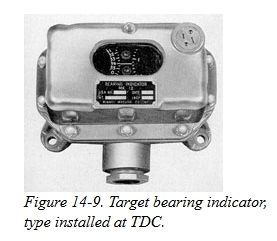
__________________
Sub Skipper's Bag of Tricks, Slightly Subnuclear Mk 14 & Cutie, Slightly Subnuclear Deck Gun, EZPlot 2.0, TMOPlot, TMOKeys, SH4CMS |
|

|

|
 09-07-15, 01:46 PM
09-07-15, 01:46 PM
|
#8 | |
|
Admiral
 |
I thought I'd put in my 2 cents worth.
As far as I know, the input for the TDC was basically a manual one. Verbal "calls" for the various settings coming from the Fire Control Party. It's true the TBT could signal in which direction it was pointed. This signal was not directly linked to the TDC. I don't believe any other inputs were automatically made. Talking about AoB and the authentic aspects of the game....the game's American Stadimeter missed the mark by a wide margin. For the most part the Periscope's Stadimeter Dial provided the bulk of the information needed for the TDC. 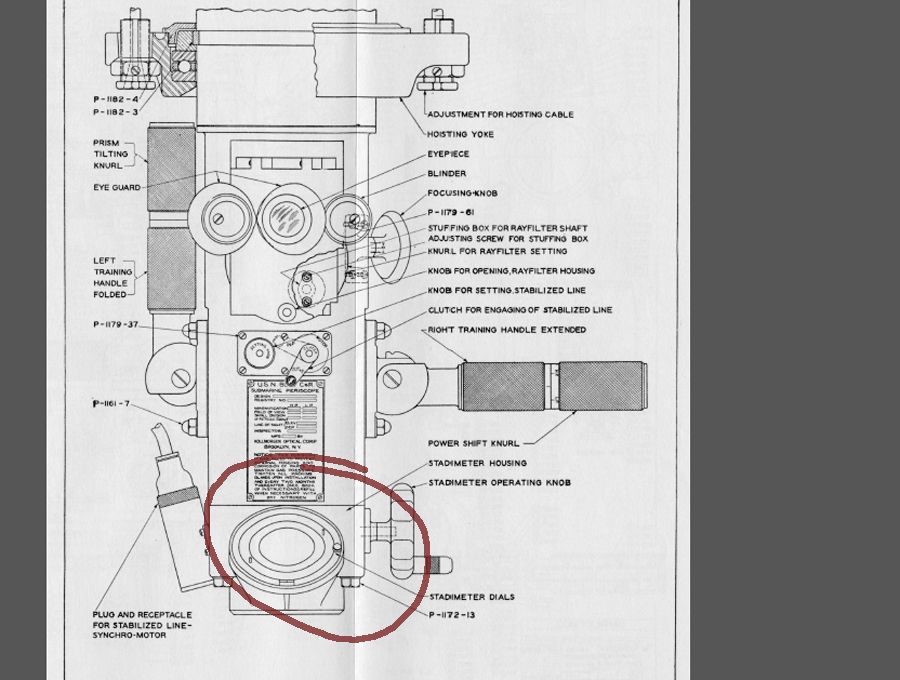 The Stadimeter Housing Unit was fastened onto the bottom of the Periscope. The outside view was brought down through a set of prisms, passing through the Stadimeter len's before going to the eye piece. It had two half len's that slide next to each other, giving the double image. Depending on which axis the sliding edge was pointed to, Up/Down, Left/Right.....the Stadimeter would produce either an estimate of target course angle (AoB), or an estimate of range. Both shown on the Stadimeter Dial. Target Aob and Range could be found within less than a minute by most Captains. Instructions were to have the "Stadimeter Operating Knob" turned in the farthest clockwise position when lowering the periscope. This created the ability to have the two Stadimeter len's first slide on the horizontal axis....giving the AoB of a target, when the Approach Officer first raises the periscope. Then with a further counter clockwise twist of the knob, the axis shifted to the vertical.....giving an estimated range (provided a height/length figure was found in the Recognition Manual, and the Stadimeter Dial was set to the appropriate measurement). This "shift" between the two axis was within a single complete turn of the Operating Knob. 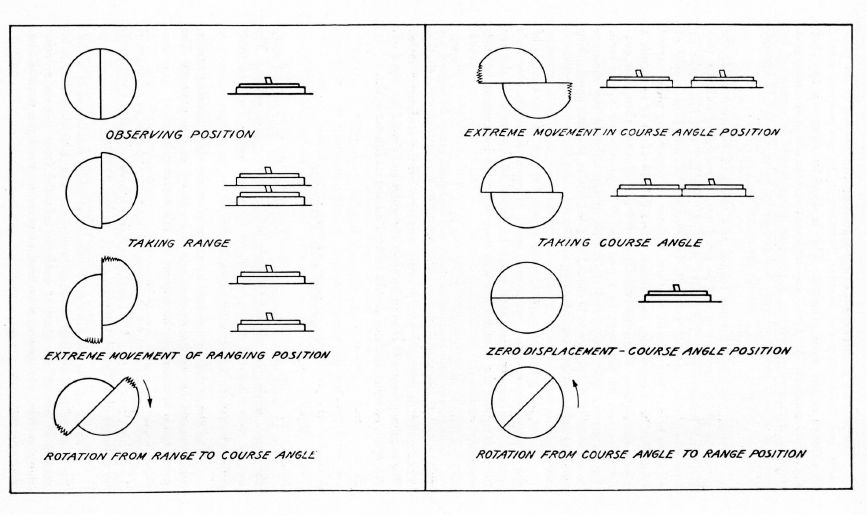 The Stadimeter had two dials, both identical, on either side of the Periscope. It was faster to have a second observer stationed at the opposite dial to make the reading of range or target course, rather than the Captain who kept his focus at the eye piece. The Stadimeter Dial automatically moved the center Dial Ring (one of three Dial Rings of the Stadimeter Dial), when you positioned the double image on the correct reference point. The third outer ring of the Dial was manually set to the "Targets Length". The inner dial ring was stationary, representing the "Targets Height". Although there was no direct link to the TDC, the observer usually called out the found range and target course to have the TDC operator input the information. Unlike the TBT (Target Bearing Transmitter), which did have direct input to the TDC operator for just target bearing. No such direct link was made from the Periscope. In both devices, the game has taken some creative license in simulating their functions and capabilities. In the Stadimeter's case, the game left out an important function for determining AoB from the real life unit. The game only allows the Stadimeter to work vertically, not horizontally. With the TBT, there was no Stadimeter to help in range finding attached to it. Neither were there Telemeter Divisions for judging range. The following image shows what a TBT view looks like, taken at the Submarine Force Library and Museum, Groton Conn. 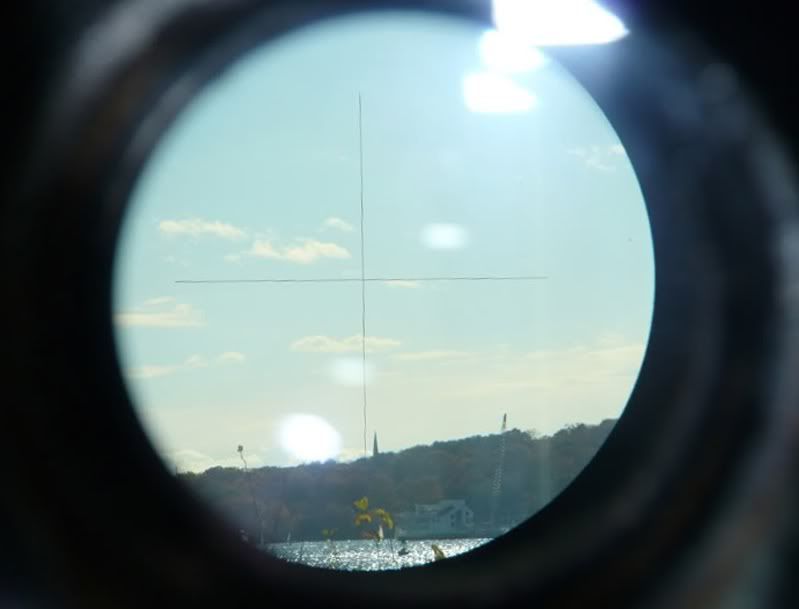 In reality, the TBT's only usefull function was to provide Relative Bearing of a focused target ========= Something else missing in-game. In the above diagram of the periscope, you will see the reference to the knob and clutch (just below the eye piece) for a "Stabilized Line". The Stabilized Azimuth Line provides a "line in space" within the field of view. It was used to determine speed of a target. The line was electrically governed by the subs gyro compass which kept the line at a singular position, irregardless of the subs possible changing position. Once the line was "plugged in" (it was not good to leave it operating for too long because the synchronizing motor could fog up the interior of the scope) the passage of the target over the line was timed with a stop watch, then calculated using the estimated target length to determine target speed. The "clutch" was used to engage the synchronous motor, that was governed by the compass. You had a cord that really was "plugged in" to make it work. As you can see, the Periscope gave you Speed, Range, Target Course (AoB)....all in one easy process. The game missed the actual simulation of this by a large margin. Not only giving us wrong height measurements, wrong scaled viewing, no length measurements (accurate or not), and incomplete simulated features of the devises used in real life.
__________________
 The HMS Shannon vs. USS Chesapeake outside Boston Harbor June 1, 1813 USS Chesapeake Captain James Lawrence lay mortally wounded... Quote:
Last edited by CapnScurvy; 09-07-15 at 09:47 PM. |
|

|

|
 09-07-15, 05:43 AM
09-07-15, 05:43 AM
|
#9 | |
|
Sea Lord
 |
Quote:
Lest you think that gives the U-boats points for technical excellence, the U-boat periscopes did not have a stadimeter. Range measurement was done with a scope graticle and the Mark 1 human eyeball! That's one Ubi didn't get right. (Source here is also existing U-boat on exhibit.) |
|

|

|
 09-07-15, 07:25 AM
09-07-15, 07:25 AM
|
#10 | |
|
Navy Seal
 |
Quote:
First you set up the TDC for what the AoB will be at time of firing. You're going to be 90º from the track and I have a rule of thumb for anything under 10 knots fire at 10º before your relative zero bearing and for anything 10-15, fire 15º before, higher speed make it 20º. That is a rule of thumb and people say "RR you're not being precise." Well, actually I am, because while I choose the shoot bearing imprecisely, the TDC figures the gyro angle very precisely. No that torpedo won't generally go right up the zero bearing. I will be a few, maybe as many as five degrees off. But according to my experience and the Submarine Torpedo Fire Control Manual, any gyro angle under 20º was considered straight shooting where range mattered very little to a valid solution. Since my error is only 25% of the allowed variance, I hit every shot. So long as you are shooting with position keeper off you can select shoot bearings arbitrarily and still get hits. With position keeper on you can shoot whenever you want so long as your solution remains valid. So I'd say the American TDC is only a disadvantage if you want to try to force it to work like the German TVR. Taken on its own terms it's excellent. And the same is true of the TVR. You can't say it's garbage based on the fact that there are differences from the TDC. After all, none of that matters. The only thing that matters is whether or not a target goes boom. If your device makes the target go boom it is a successful device. But as for your question, with the American TDC you are not selecting the lead angle. You are selecting the shoot bearing and the TDC calculates the correct lead angle, inputs the gyro angle automatically (with manual backup available) to the torpedo and it hits. In my video, I blew the attack and ran my mouth as the target ran past my shoot bearing. Rather than quit and begin again, I just aimed the crosshairs at the bow and stabbed the "send bearing and range to TDC" button, then fired four. All four hit when my AoB was 10º wrong for when I shot. The reason is that the TDC calculated a new gyro angle based on my erroneous input, firing 10º too late, and it was still plenty close enough. I published the video as an example of how error tolerant the Dick O'Kane attack is. That's because of how versatile the TDC is.
__________________
Sub Skipper's Bag of Tricks, Slightly Subnuclear Mk 14 & Cutie, Slightly Subnuclear Deck Gun, EZPlot 2.0, TMOPlot, TMOKeys, SH4CMS Last edited by Rockin Robbins; 09-07-15 at 07:36 AM. |
|

|

|
 09-07-15, 08:28 PM
09-07-15, 08:28 PM
|
#11 | ||
|
Silent Hunter
 Join Date: Sep 2010
Posts: 3,975
Downloads: 153
Uploads: 11
|
Quote:
This matches my understanding of the USN's fire control and procedures.From BigWalleye: Quote:
I don't see what you mean here. |
||

|

|
 09-07-15, 09:53 PM
09-07-15, 09:53 PM
|
#12 | ||
|
Admiral
 |
Quote:
__________________
 The HMS Shannon vs. USS Chesapeake outside Boston Harbor June 1, 1813 USS Chesapeake Captain James Lawrence lay mortally wounded... Quote:
|
||

|

|
 09-08-15, 06:37 PM
09-08-15, 06:37 PM
|
#13 | |
|
Captain
 Join Date: Aug 2009
Posts: 481
Downloads: 74
Uploads: 3
|
Since we as captains aren't actually operating the TDC directly, I honestly don't see the practical difference between the tbt sending bearing information directly to the tdc and the tbt sending bearing information to the tdc operator who then enters it into the tdc.
That being said, there is something very important in the link provided by snakedocpl. It says directly on the very same page: Quote:
__________________
My SH4 LP |
|

|

|
 09-07-15, 10:04 PM
09-07-15, 10:04 PM
|
#14 | |
|
Sea Lord
 |
Quote:
|
|

|

|
 09-08-15, 06:16 PM
09-08-15, 06:16 PM
|
#15 | |
|
Eternal Patrol
 |
Quote:

__________________
“Never do anything you can't take back.” —Rocky Russo |
|

|

|
 |
|
|
